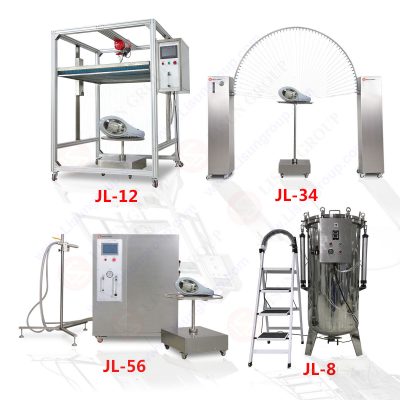

Waterproof test chambers are critical tools for evaluating the water resistance of household, commercial, and industrial electrical and electronic equipment. These chambers adhere to international standards such as IEC 60529, GB 4208, GB/T 10485-2007, DIN 40050-9, ISO 20653, and ISO 16750, providing standardized testing for various levels of water protection. The IP (Ingress Protection) rating system includes nine distinct levels, each corresponding to specific testing methods. Below is a detailed overview of the definitions and testing methods for each IP water protection level:
waterproof test Equipment JL-X
IP Protection Level Definitions
IPX1:
• Testing Method: Vertical Drip Test
• Equipment: Drip Test Apparatus
• Sample Placement: Sample in its normal operating position, with the top of the sample no more than 200mm from the drip nozzle.
• Test Conditions: Drip rate of 1.0 ± 0.5 mm/min
• Test Duration: 10 minutes
IPX2:
• Testing Method: 15° Tilt Drip Test
• Equipment: Drip Test Apparatus
• Sample Placement: Sample tilted at a 15° angle from the vertical, with the top of the sample no more than 20mm from the drip nozzle.
• Test Conditions: Drip rate of 3.0 ± 0.5 mm/min
• Test Duration: 4 cycles of 2.5 minutes each, totaling 10 minutes
IPX3:
a. Oscillating Tube Spray Test
• Equipment: Oscillating Tube Spray Test Apparatus
• Sample Placement: Sample centered in the half-circle of the oscillating tube, with the top of the sample no more than 200mm • from the spray nozzle.
• Test Conditions: Water flow rate of 0.07 L/min, spraying from 60° arcs on either side of the tube’s midpoint.
• Test Duration: Continuous spraying for 10 minutes, rotating the sample 90° after 5 minutes.
b. Handheld Spray Test
• Equipment: Handheld Spray Test Apparatus
• Sample Placement: Top of the sample 300mm to 500mm from the handheld spray nozzle.
• Test Conditions: Water flow rate of 10 L/min
• Test Duration: 1 minute per square meter of sample surface area, with a minimum of 5 minutes
IPX4:
a. Pressure-Sprayed Tube Rain Test
• Equipment: Oscillating Tube Spray Test Apparatus
• Sample Placement: Sample centered in the half-circle of the oscillating tube, with the top of the sample no more than 20mm from the spray nozzle.
• Test Conditions: Water flow rate of 0.6 ± 0.5 L/min per nozzle, with the tube oscillating 180° on either side.
• Test Pressure: 400 kPa
b. Handheld Splash Test
• Equipment: Handheld Spray Test Apparatus
• Sample Placement: Remove any covers installed on the equipment; top of the sample 300mm to 500mm from the handheld spray nozzle.
• Test Conditions: Water flow rate of 10 L/min
• Test Pressure: 1 minute per square meter of sample surface area, with a minimum of 5 minutes
IPX5:
• Testing Method: Water Jet Test
• Equipment: Nozzle with an inner diameter of 6.3mm
• Test Conditions: Distance from the sample to the nozzle is 2.5 to 3m, with a water flow rate of 12.5 L/min
• Test Duration: 1 minute per square meter of sample surface area, with a minimum of 3 minutes
IPX6:
• Testing Method: Powerful Water Jet Test
• Equipment: Nozzle with an inner diameter of 12.5mm
• Test Conditions: Distance from the sample to the nozzle is 2.5 to 3m, with a water flow rate of 100 L/min
• Test Duration: 1 minute per square meter of sample surface area, with a minimum of 3 minutes
IPX7:
• Testing Method: Short-Term Immersion Test
• Equipment: Immersion Tank
• Test Conditions: The sample’s bottom must be at least 1m below the water surface, and the top of the sample must be at least 0.15m above the water surface.
• Test Duration: 30 minutes
IPX8:
• Testing Method: Continuous Immersion Test
• Equipment: To be agreed upon by both parties
• Test Conditions: The test severity must exceed that of IPX7
IPX9:
• Testing Method: High-Pressure Jet Test
• Equipment: Nozzle with an inner diameter of 12.5mm
• Test Conditions: Spray angles of 0°, 30°, 60°, 90°, with 4 spray nozzles, sample platform rotating at 5 ± 1 r.p.m., distance 100 to 150mm
• Test Duration: 30 seconds per angle, totaling 120 seconds
Summary:
Understanding the testing methods and requirements for each IP protection level is essential for ensuring a device’s water resistance. Waterproof test chambers, through these standardized tests, help determine the protective capability of electronic devices under various environmental conditions, thereby enhancing their reliability and durability. https://www.lisungroup.com/news/technology-news/understanding-ip-protection-levels-in-waterproof-test-chambers.html


Comments
Post a Comment